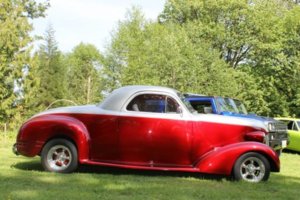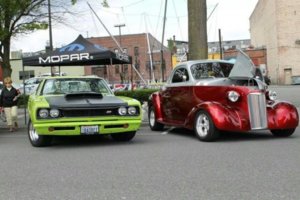Mine was my front disc conversion. The conversion of the knuckles, rotors, calipers, etc was straightforward and went without an issue. I had to replace all of the brake lines as they were damaged getting the porportioning block changed out. Had everything plumbed back together after four weeks of waiting for the correct parts from In Line Tube. New rear wheel cylinders and rubber line while I was at it.
Ready to bleed. Rear bleeded fine. Front was nothing. Not a drop to either caliper. Called and emailed Dr Diff. He said to bench bleed master again. Removed master and bench bleed again. Reinstalled. Rear bleeds fine. One drop of fluid out of the passenger caliper, drivers caliper dry. Dr Diff says to re-bleed the master cylinder. Bench bleed on car this time, then realize that there is not much pressure on rear master output. Reinstalled lines. Yes, the rear bleed fine, one drop of fluid at the fronts. Bench bleed master again with fellow A body Mopar collector that has restored several mopars over the years. Then strip out master cylinder putting lines back in. Dr Diff graciously backed up his product with a new master, including shipping, no charge.
Reinstalled everything. This time has fellow A Body mopar expert perform the bleed. Same issue; rear is fine, can't get front to bleed. He suggests gravity bleed for the front for overnight. Next morning two drops of fluid out of the passenger caliper, nothing out of the driver caliper. A body expert claims porportioning block is the problem, and throws in the towel.
Discussed with Dr Diff. Tried a few things (lines off the blaock, fluid flows) and proved porportioning block flows fluid.
Bought a MitiVac on recommendation of a friend. Rear bleed good again, passenger front bleeds, but always bubbles. Drivers front just sucks air.
Called InLine Tube and got no advice.
Hired my coworker who is a mechanical engineer, former Porsche/BMW shop mechanic, and wrench turner for hire on weekends for $45/hour. He is an excellent mechanic and just completed his 66 Chevelle LS1 swap. He recommended all along for me to hire him to make my brake lines as he has the Eastwood Brake Line tools, fixtures, double flare kits, etc. In less than 10 minutes he claims the drivers front hard line is probably sucking air. Removed that line and sure enough the double flare on BOTH ends is off center! He makes a new line with his impressive tools.
Back to two man brake bleeding. Rear is still good. Passenger front bleeds better but never could eliminate all bubbles. Drivers front now flows, but with bubbles.
He goes back and forth tightening and re tightening all tube nuts on the lines. Same issue.
Finally he gives me two choices; make another new brake line for the passenger front, or get out the vise grips and tighten the front brake lines until the tube nuts round off. I say what do I have to lose? Get out the Vise Grips.
Brakes bleed fine on all four wheels. I give him 3 $50 bills and am happy.

















